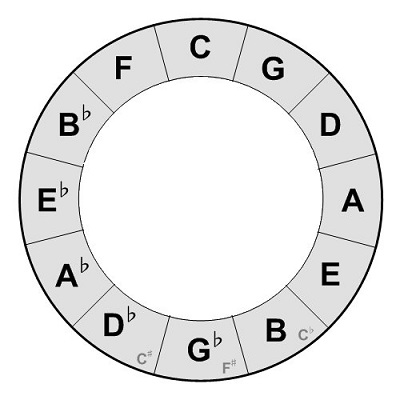… So What Does This Mean?
Well, this simply means that you can go round the ENTIRE circle with these types of close relationships not having to change more than a few fingers from one note to the next.
If C to F produces an easy transition, then F to Bb … Bb to Eb … Eb to Ab, and so on must produce the same effect:

Here are three exercises you can practice every day to better familiarize yourself with the circle of fifths, as this concept is very important when attempting to understand chord progressions like 2-5-1, 1-4 turnarounds, and many others
Exercises
1) Major SeventhsBasically, here’s what you do with this exercise…
Start with Cmaj7:
C + E + G + B… and instead of going to F A C E (which is an Fmaj7 in root position), you’re going to go to the closest inversion of the Fmaj7.
Remember, - An inversion is another way to play the same chord.
There are four ways (inversions) to play an Fmaj7
F + A + C + E
A + C + E + F
C + E + F + A
E + F + A + C
So which inversion would work best coming from a Cmaj7 (C + E + G + B) ?
Of course the
C + E + F + A because your lowest note is already on C!
Do you follow me?
So, in fact, we’re just picking the closest inversion of Fmaj and in this case, it happens to be
C + E + F + A.
A few tricks: You need to read this carefully!
When you’re playing a root inversion of a major seventh chord (root inversions always put the name of the chord on the bottom… so Cmaj7 played C E G B is in its root inversion because C is on the bottom).
Now simply move the top two notes
down one whole step and you’ll be on the next chord of the circle!
Like this
Cmaj7
C E G B (Bass = C)
*** Move the G down one whole step to F
*** Move the B down one whole step to A
Fmaj7
C E F A (Bass = F)
Now to get from the Fmaj7 to the next chord on the chart, which is Bbmaj7 simply lower the bottom two notes by one whole step.
Like this
C E F A (Bass = F)
*** Move C down one whole step to Bb
*** Move E down one whole step to D
Bbmaj7
Bb D F A (in its root position) Bass = Bb
…. and now, you simply follow the first step by lowering its highest two notes down to get to the next chord......and so on.
Don’t worry if you don’t understand these steps yet. Just re-read this post and it’ll make sense soon!
If not, just skip down to the actual chart below and play EXACTLY what I’ve listed in each box. There’s no way you can go wrong.
Summary:
1) Lower highest two notes down one-whole step
2) Lower lowest two notes down one-whole step
3) Repeat process over and over (highest two, lowest two, highest two, lowest two).
Make this your first exercise.
Let me warn you: The first time, you’ll be doing a lot of thinking (high two, low two, high two, low two) but as you get better and better, you’ll build speed and you’ll know which chords come next on the circle.
In the next Reply, I spell out this exercise for you.
Peter